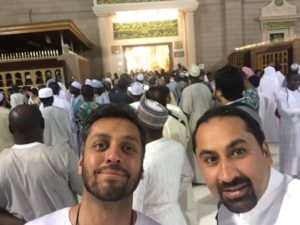Fourteen hundred years ago, the Prophet Muhammad and his companions definitely didn’t have to decide between Clarendon and Gingham filters to document the hajj pilgrimage that is recreated by Muslims each year. But then again, they didn’t have Instagram as I did when I went to Mecca to satisfy the pillar of my faith during the last days of August and the beginning of September. They didn’t have access to the air-conditioned tents that I used for shelter. And when they gazed at the Kaaba — the austere black cube that represents God’s house on earth — it certainly wasn’t dwarfed, as it is now, by the enormous luxury hotel and bling-covered clock tower that the Saudi government added to the landscape in 2012.

Awe-struck by the privilege of participating in this tradition while often agitated by the contradictions that surround it today, I made sense of the experience by sharing it — filtering the pilgrimage through the lens of my smartphone.
The most painful aspect of hajj wasn’t the physical toll that came with navigating cramped space with my two million diverse fellow pilgrims, or the intense spiritual concentration. It wasn’t the hiking-induced blisters and chafing. It was witnessing the erasure and razing of my religion’s culture, history and narrative by the House of Saud.
The Saudi royal family follows the revisionist and extreme ideology of Wahhabism, which preaches an interpretation of strict monotheism that is often at odds with centuries of theological scholarship. They consider veneration and respect of most holy sites and visitations of graves as a form of idolatry.
That explains why, in their country, while the Prophet Muhammad’s mosque and courtyard in Medina are spacious, cooled and immaculate, Jannat al-Baqi — a graveyard directly across from the green dome housing the remains of thousands of Islam’s luminaries — looks like a set from “Mad Max: Fury Road.” There are no tombstones, just slabs of rock sticking out like middle fingers from the dirt. If you linger too long to pay respects or offer a prayer, the mutawwa — religious police — rush you along. When you ask them who’s buried here, they answer, “Allah knows best,” although they know the truth: the daughter of the prophet, his family members and some of his most loyal companions.
My friends and I spent hours at the prophet’s tomb and the rawdah — a space between his original pulpit and grave considered by Muslims to be some of the hottest spiritual real estate on earth. The moving experience was tempered by the awareness that most Muslims long to offer their “salaams” (prayers of peace) to the prophet, but cannot afford to visit his mosque. Also, women are often unable to properly perform the “ziyarat” (religious visitation) there because they’re allowed only limited access.
In Mecca, I hiked nearly an hour under the remorseless afternoon sun to visit the Cave of Hira, where the prophet is believed to have received his first revelation: “Recite!” There are no golden signs, air-conditioning, wheelchair ramps or video presentations here. The austere cave used to offer a clear line of sight to the Kaaba, but now the view is now obscured by that monstrous, $15 billion, Saudi-government-funded clock tower and the accompanying world’s tallest hotel.


